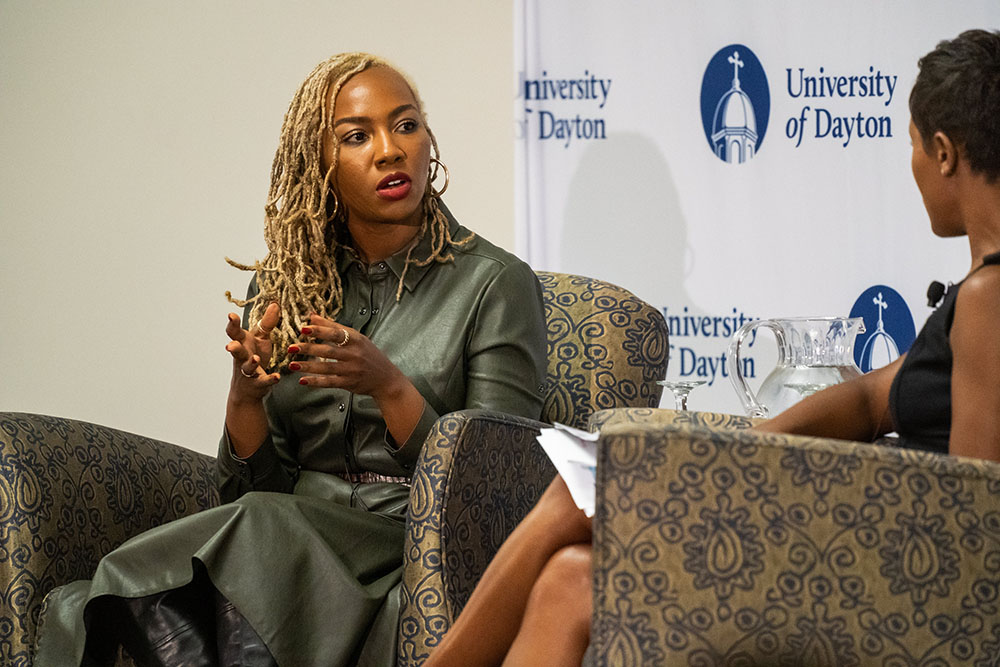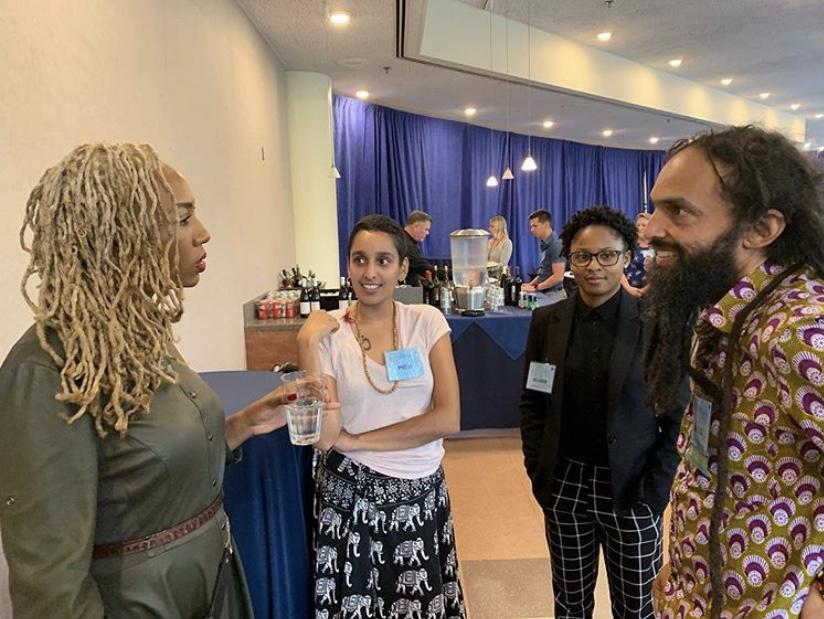Let's Talk Human Rights

Reimagining Social Justice through the #BlackLivesMatter Movement
By Jameela Henderson 3L, UDSL and Davis Schwartz 3L, UDSL
Ohio Community Organizer and Blacktivist Meets Opal Tometi, Co-founder of Black Lives Matter, and Flame is Reignited
Author: Jameela Henderson
 Photo credit: Youssef Farhat. Pictured left to right: Opal Tometi, Darsheel Kaur, Jameela Henderson, Amaha Sellassie
Photo credit: Youssef Farhat. Pictured left to right: Opal Tometi, Darsheel Kaur, Jameela Henderson, Amaha Sellassie
I recently saw Opal Tometi, co-founder of Black Lives Matter (BLM), speak at the Social Practice of Human Rights Conference 2019. Tometi’s keynote addressed how BLM created a space for people to organize around the government system’s broken power dynamic and the over-policing of Black bodies. The three women co-founders of BLM: Patrisse Khan-Cullors, Alicia Garza, and Opal Tometi, knew that black people in America needed something to rally us. The hashtag was the rally point; it allowed individuals all over the world to share the same battle cry throughout many different social media platforms. BLM created a space where we could talk about white supremacy and how it affects every aspect of our lives. BLM stands for real justice. Many times, when a white person or police officer shoots a person of color, the charges are dropped, or the perpetrator is found not guilty at trial. Less commonly, the perpetrator will receive a guilty verdict and is held accountable for their actions. Although this is considered justice to some, the real justice would be for Black people to live. Justice is when a Black person is never murdered for the color of their skin again.
Opal reflected on the rage, hurt, sadness, and grief I felt when we watched as the media and court tried to put Trayvon Martin on trial for his own murder instead of the man who took Trayvon’s life. The defense put Trayvon on trial to argue that Zimmerman feared for his life, when in reality Zimmerman stalked the boy and murdered him. I remember when Zimmerman’s verdict came down and I was in disbelief. I thought that he would undoubtedly be convicted because of the recorded calls to the police, his refusal to back down and leave Trayvon alone, and the fact that “stand your ground” could not possibly apply in this situation.
I have followed BLM from the beginning of the simple social media tag #BlackLivesMatter, to the sweeping movement that ensued. The trial of Trayvon Martin and Black Lives Matter movement ignited my flame. I was very active in BLM, so I was personally involved in many of the stories and events Opal spoke about. In October 2014, there was a call for justice, #JusticeforJohnCrawford, so I joined the Ohio Student Association and other community members in occupying the Beavercreek police station to protest the death of John Crawford III. A group of young people were demanding the police make systemic changes, be accountable, and fire the man that murdered John Crawford III. This was my first experience being involved in fighting for justice for Black Lives. I also went to Ferguson, Missouri for “Ferguson October” to protest the killing of Mike Brown. I remember feeling loved and important when #BlackLivesMatter was created: the movement felt like home.
Opal explained how 40% of the 2.3 million people incarcerated in the U.S. are Black, despite the fact that Black people make up 14% of the U.S. population. There has to be systemic change to the justice system because it disproportionately affects Black people. We all have to work together to reimagine present day laws, overcome systematic oppression, and renew the justice system.
BLM created a cultural shift in the US and in me. There is anti-Black racism happening all over the world. All of our liberation is tied to one other, so activists in other countries who also are affected by over-policing have been waiting for the black population in America to wake up and fight for change.
Opal's keynote impacted me greatly; it reignited my passion for social justice...it reminded me why I fell in love with social justice and community change. It reminded me of the many reasons I have to continue to fight for real justice. This experience helped me reimagine practicing law and creating community change through social justice. I will continue to fight for justice through my practice of law. I will continue to fight for “Justice” and not just follow the laws that were not created to help people who look like me.
Jameela is a third-year student at the University of Dayton School of Law. She is a former member of The Ohio Student Association, where she was a community organizer. She is interested in social justice and learning how to merge social justice with law.
White People Need to Do Better
Author: Davis Schwartz
“When we say 'Black Lives Matter,' we're not saying that any other life doesn't matter. That has never, ever been our message. Our message has always been from a place of love.” – Opal Tometi. Human rights are predicated on the notion that they are inherent to everyone “regardless of race, sex, nationality, ethnicity, language, religion, or any other status.” I spent an evening listening to Opal Tometi, co-founder of the Black Lives Matter (BLM) movement, and as a white person, this is the message I took away.
Opal points out that some people misconstrue the message that Black Lives Matter attempts to share with the world. The “All Lives Matter” response to the movement distorts the genesis of the message of Black Lives Matter. As a twitter user so aptly put it:
"Your neighbour’s house is on fire. You call 9-11. The firefighters come to put out the fire. Are you and your neighbours going to be like what about our houses? Don’t we all get a little bit of water on our houses? Of course not Maryanne, because your house is not on fire right now and it does not need the attention right now.” @JlTEAGEGE
In a similar vein, those who advocate that “All Lives Matter” by proxy of their message attempt to take resources away from the communities that need support the most. When society or governments evenly spread resources, even to those that do not need the resources, we tend to be under resourced and no change ensues. After all the resource spreading, we are left in the same position where some communities are in a better position than others. This reinforces a status quo of inequality.
Yet, that begs the question why certain communities are in disadvantaged positions compared to others. The answer is structural racism. The complex system by which racism is developed, maintained, and protected is referred to as structural racism. As activist and writer Frank Leon Roberts said: “Black Lives Matter has always been more of a human rights movement rather than a civil rights movement. BLM's focus has been less about changing specific laws and more about fighting for a fundamental reordering of society wherein Black lives are free from systematic dehumanization.” Structural racism manifests itself in practices such as the racial wealth gap, low Black homeownership, and credit score disparities among racial groups. These structures prioritize white life.
I think we must look to equitable human rights to remedy structural racism. That is to say, we must take affirmative measures to ensure human rights actually exist and can be enjoyed by everyone. Fundamentally, equity enhances fairness amongst the people. Instead of giving everyone the same tools, each person gets the adequate tools so they can succeed. The introduction of equity into a life is the key to freedom and liberty—the hallmarks of human rights. Human rights do not stop at just freedom and liberty. Human rights include freedom from torture, freedom of association, the right to vote, due process of law, etc. These rights must be thought of in the real sense, and not the theoretical, because when we think of torture in the traditional sense we can lull ourselves into complacency. Simply put, police brutality against minority communities is a type of torture. And thus, an affirmative measure to ensure minority communities (and by-extension white people) are not subjected to police brutality benefits everyone involved. Some may say that equity undermines the universality of human rights, but that misses the point. The point is that some rights are enjoyed more by certain communities, and sometimes measures need to be taken so everyone gets to enjoy that right the same. When we lose sight of the differences between equality and equity—we give room to those who want to undermine both, but under the façade of seeking equality.
To conclude, my message is: do not let Maryanne get water on her house when your house is burning down just to make her feel better, because indulging her destroys an equitable solution to the problem. And that includes educating Maryanne that her house is not—and never has been—on fire; so, she needs to allow the water to put out the flames of structural racism.
Davis is a third-year law student at the University of Dayton School of Law. Before law school, he received an Honours Bachelor of Social Sciences with a Major in Political Science with a Minor in United States Studies from the University of Ottawa.
